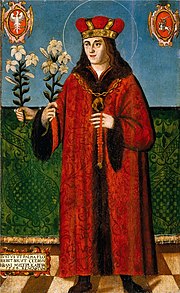Casimir | |
|---|---|
 Three-Handed Saint Casimir (16th century) is considered to be miraculous. He is depicted wearing Gediminas' Cap. | |
| Confessor | |
| Born | 3 October 1458 Wawel, Kraków, Kingdom of Poland |
| Died | 4 March 1484 (aged 25) Grodno, Grand Duchy of Lithuania |
| Venerated in | Roman Catholic Church |
| Canonized | 1521 or 1602, Rome, Papal States, by Pope Leo X or Pope Clement VIII |
| Major shrine |
|
| Feast | 4 March[1] |
| Attributes | Lily, grand ducal cap |
| Patronage | Lithuania (1636), Lithuanian youth (1948) |
Casimir Jagiellon (Latin: Casimirus; Belarusian: Казімер; Polish: Kazimierz; 3 October 1458 – 4 March 1484) was a prince of the Kingdom of Poland and of the Grand Duchy of Lithuania. The second son of King Casimir IV Jagiellon, he was tutored by Johannes Longinus, a Polish chronicler and diplomat. After his elder brother Vladislaus was elected as King of Bohemia in 1471, Casimir became the heir apparent. At the age of 13, Casimir participated in the failed military campaign to install him as King of Hungary. He became known for his piety, devotion to God, and generosity towards the sick and poor. He became ill (most likely with tuberculosis) and died at the age of 25. He was buried in Vilnius Cathedral. His canonization was initiated by his brother King Sigismund I the Old in 1514 and the tradition holds that he was canonized in 1521.
Veneration of Casimir saw a resurgence in the 17th century when his feast day was confirmed by the pope in 1602 and the dedicated Chapel of Saint Casimir was completed in 1636. Casimir became a patron saint of Lithuania and Lithuanian youth. In Vilnius, his feast day is marked annually with Kaziuko mugė (a trade fair) held on the Sunday nearest to 4 March, the anniversary of his death. There are more than 50 churches named after Casimir in Lithuania and Poland, including Church of St. Casimir, Vilnius and St. Kazimierz Church, Warsaw, and more than 50 churches in Lithuanian and Polish diaspora communities in America. Women's congregation Sisters of Saint Casimir was established in 1908 and remains active in the United States.
- ^ Jestice, Phyllis G. (2004). Holy People of the World: A Cross-cultural Encyclopedia. ABC-CLIO. p. 160. ISBN 978-1-57607-355-1.